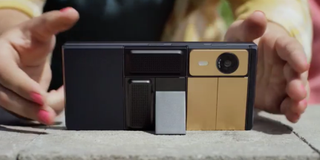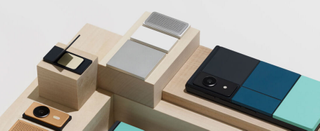Project Ara Coming, Again

Stop me if you’ve heard this one before: Project Ara, the Google ATAP modular smartphone project, is nigh. At Google I/O, the ATAP group announced (again) that the phone is finally coming, and the team had a working prototype on the stage (again).
Promises, Promises
You’d be forgiven if your vaporware detector is going off. Ara was first announced in 2013, which is decades in tech years. I heard tales of a working Ara prototype as far back as 2014’s Ara Dev conference, and last year at I/O there was a working prototype on stage. A year past that, and another working prototype on stage at I/O.
Today, the group promised to roll out the Developer Edition of the phone this fall, and that’s exciting, but this isn’t the first time an Ara promise has evaporated. For example, remember the Puerto Rico pilot program that was supposed to launch in 2015? It never happened. At MWC 2015, we learned that Yezz, Toshiba and Marvell were all developing modules for Project Ara. We haven’t heard a peep since. (Although that may be at least partially on the shoulders of those module makers; Yezz’s other big project, the Sfera two-camera smartphone, has apparently stalled out as well.)
In fact, the only activity we’ve really seen in the last year was a slightly awkward PR exchange on the official Ara Twitter feed. There was a sort-of joke about failed drop tests, which was really just a way of saying the team was scrapping the idea of electropermanent magnets to hold all the cores to the endo.
Even today’s revelations about the new way the Ara phone is put together doesn’t bring one much faith — we’ve already been through this rigamarole, back in 2014.
MORE: Where Are You Going, Project Ara? (Opinion)

How (The Latest Iteration) Is Put Together
Stay on the Cutting Edge
Join the experts who read Tom's Hardware for the inside track on enthusiast PC tech news — and have for over 25 years. We'll send breaking news and in-depth reviews of CPUs, GPUs, AI, maker hardware and more straight to your inbox.
There’s next to no information on the Project Ara website (which worries me), but according to the most recent announcements, the Ara phone will be comprised of a frame, modules, the “Greybus” software stack, baseplate — and an open marketplace.
Frame And Modules
The frame is about what you’d expect--it’s the skeleton into which you can slot modules, and it looks similar to previous versions. In this iteration, there are “six flexible slots,” and judging from the renders, it looks like there are five primary sections within the 3x6 frame:
-1x2 on the top left side-1x2 on the middle left side-2x2 on the top right side (that can be split into two 2x1 modules)-2x2 on the middle right side (that can be split into two 2x1 modules)-3x2 section on the bottom of the phone that spans the whole width of the frame.
I believe that the SoC is housed in the 3x2 section, so the modules will all fit into the top slots. Again, working off of the renders, it would seem that you could plug in some variation of up to six 1x2 modules, but the two right-side slots can each accommodate either two 1x2 modules or one 2x2 module.

Presumably, then, all of the modules that third parties make will be either 1x2 or 2x2.
The frame contains the SoC, which will house all the basics: “CPU, GPU, antennas, sensors, battery and display,” read the Ara site. It also employs “durable latches and connectors” to keep the modules snugly in place, Ara stated that they’re built around “standards” but did not elaborate further other than to indicate that this would somewhat future-proof modules for next-gen frames.
Baseplate And Greybus
Both the frame and the modules will apparently nestle into a baseplate. It looks little more than a simple frame (not to be confused with the aformentioned “frame”), and Ara described its function with the following:
“The Ara baseplate provides an instant connection to the Ara frame and its core technologies. That means less time fiddling and more time building.”
In any case, the baseplate and the Greybus software work together to provide hot swap functionality. You should be able to freely pop modules in or out of the frame and enjoy “instantaneous, power efficiency and data-transfer rates of up to 11.9 Gbps.”
For scale, that’s nearly four times slower than Thunderbolt 3’s 40 Gbps, although it’s only about three times slower than TB3’s effective throughput of approximately 32 Gbps. Most USB 3.1 ports handle data at 5Gbps, and SATA III is 6 Gbps. Considering the types and amount of data that each module would demand, 11.9 Gbps should be up to the task.

Marketplace
There will be an “open marketplace” for Project Ara...modules? Apps? The group didn’t say, exactly, other than this:
“We're hard at work on an open marketplace to connect the next generation of ideas with the broader Ara community. Google is looking for beloved brands and forward-thinking developers to join us.”
Whatever the plan, Google can and should establish a module market, using the same model as the Play Store, where we get some information about what it does and how it works and who makes it, and user comments add some insight. Google may even have a few branded modules of its own.
It would make sense to try and push some of the modules into brick-and-mortar stores so people can play with them and try them out and have a destination at which to gather. This is a strategy long used by Apple, and Microsoft and even Razer have warmed up to the philosophy that getting foot traffic is a wise way to do business.
This possibility is on display, as it were, on the Ara site. This render looks a lot like a physical product, doesn’t it? Of course, maybe you could simply view modules in a daydream (cough, cough).

Any online module store will certainly be a mere extension of the Google Play Store. Project Ara will run on Android, and therefore will run Android apps. (If there was any doubt, note that the Greybus software is “deep in the Android stack.”)
Partners, And New Goals
All of the above will depend on partner buy-in. On that, it seems like Project Ara has taken a new tack. For example, ATAP seems keen on some health-related applications, such as diabetes monitoring. You can see that in the (rather slim) development partner list the team shared: iHealth, Cohero Health and BacTrack.
There are, of course, more typical partners such as Samsung, Toshiba, Micron, Panasonic, Harman, goTenna and TDK.
Looking at the fun, rock-and-roll promo video (above), Project Ara seems aimed at plenty of applications from playing music to recording music to navigating the wilderness to photography, and more. That is to say, both consumer and prosumer uses. (I wouldn’t mind dropping in a high-end camera module, microphone module and beefy storage module and heading off to cover a trade show, leaving my DSLR and digital recorder at home.)

Consumer Project Ara Phone?
The final tidbit from today’s onstage announcement concerned the consumer version of Project Ara, which the ATAP group said will launch “next year.” We don’t know anything more than that about the final version of the phone at this point.
For as disappointing as Project Ara has been in terms of broken promises, this was never going to be an easy endeavor, so it’s not shocking that there have been problems and delays and redesigns. But this is likely the last stand; if this iteration of Project Ara falls flat, we wouldn’t be surprised to see Google quietly put it to sleep.
Seth Colaner is the News Director for Tom's Hardware. Follow him on Twitter @SethColaner. Follow us on Facebook, Google+, RSS, Twitter and YouTube.
-
schm1tty The SOC is located in the frame with all the other essentials for running the phone(battery, ram, etc) according to the project ara website.Reply -
Theez "The Ara frame contains the CPU, GPU, antennas, sensors, battery and display, freeing up more room for hardware in each module. We are looking to module makers to create technology never before seen on smartphones."Reply
So basically i can't swap out anything that the original ara would let me.(what i for one was intrested in the first place!!!!). I mean the whole ara was about modularity. Now this is just a phone with swappable speakers, camera and gps. -
gunbust3r What happened to the golden retriever and rainbow modules? Did they decide making it look like a lisa frank disaster you would purchase at 7-11 was a bad idea after all? I guess its going for the original render that got the geeks all wet. A $600 phone that falls apart.Reply -
scolaner ReplyThe SOC is located in the frame with all the other essentials for running the phone(battery, ram, etc) according to the project ara website.
...right. As I stated in the article. But because of the vague language, I think all those parts are housed in that 3x2 "module." Look at any of the renders, and every shot in the video: It's the only part that never changes. Plus, they have to cram all that stuff SOMEwhere. -
scolaner Reply18011795 said:this is garbaaaaauj. speakers, gps, camera and hispters..... shudders....
Maybe the biggest mistake is the hipsters. This could be ideal for pro, enterprise and industrial applications. -
schm1tty The SOC is located in the frame with all the other essentials for running the phone(battery, ram, etc) according to the project ara website.Reply
Most Popular



